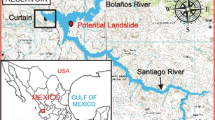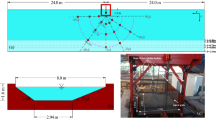Conclusion
The results of the calculations and modeling indicated that a wave that will top the crest of the dam can form during the collapse of a landfall with a volume of up to 1 million m3. The design therefore specifies a 3-m increase in dam's crest, and the construction of a wave-protection dike near the village of Dzorashen to ensure the dam's preservation.
Similar content being viewed by others
Literature cited
A Method for Geologic-Engineering Surveys of High Landslide and Landfall Slopes [in Russian], Moscow State University (1980).
S. S. Grigoryan, “A new friction law and mechanism for large-scale mountain landslides and landfalls,” Dokl. Akad. Nauk SSSR,244, No. 4.
S. S. Grigoryan, N. I. Nilov, A. V. Ostroumov, and V. S. Fedorenko, “Mathematical modeling of large-volume mountain landslides and landfalls,” Inzh. Geol., No. 6 (1983).
T. L. Gvelesiani and L. I. Rozentur, “Gravitational waves in a reservoir, generated as a result of interaction between a landslide-landfall body and the water medium (plane problem),” Deponir. Nauchn. Raboty, No. 6 (1986).
T. L. Gvelesiani, “Quantitative characteristics of earthquake-excited waves on the water surface in a reservoir,” Seismic Effects on Water-Development and Power-Generating Structures [in Russian], Nauka, Moscow (1980).
T. L. Gvelesiani, “Basis of recommendations on the schematization of a reservoir and landslides (landfalls) and determination of correction factors in calculating landslide-induced waves at the dam,” Collection of Scientific Works. Investigation of Questions Concerning the Hydraulics of Structures and Hydraulic Facilities [in Russian], Énergoatomizdat, Moscow (1984).
V. M. Seimov, B. N. Ostroverkh, and A. I. Ermolenko, Dynamics and Earthquake Resistance of Water-Development Structures [in Russian], Nauka Dumka, Kiev (1983).
L. I. Rozentur, “Computation of landslide-induced waves in a reservoir with allowance for the deformation of its boundaries and the effect of hydrodynamic forces in the movement of the landslide-landfall body. Algorithms and programs,” Inform. Byull. No. 5085000105 (1985).
T. L. Gvelesiani, “Computation of the maximum height of a landslide-induced wave at a dam for a comparatively short landslide-landfall front,” Stroit. v Osobykh Uslov. Seismost. Stroit., Ser. 14, No. 5 (1986).
V. M. Lyatkher, A. I. Militeev, and S. Ya. Shkol'nikov, “Calculation of the inland surge of tsunami waves,” in: Open-Ocean Study of Tsunamis [in Russian], Nauka, Moscow (1978).
Additional information
Translated from Gidrotekhnicheskoe Stroitel'stvo, No. 12, pp. 46–49, December, 1989.
Rights and permissions
About this article
Cite this article
Gvelesiani, T.L., Ostroverkh, B.N., Dzhindzhikhashvili, G.Y. et al. Predicting wave formation in mountain reservoirs during landfalls and landslides. Hydrotechnical Construction 23, 725–730 (1989). https://doi.org/10.1007/BF01440341
Issue Date:
DOI: https://doi.org/10.1007/BF01440341




